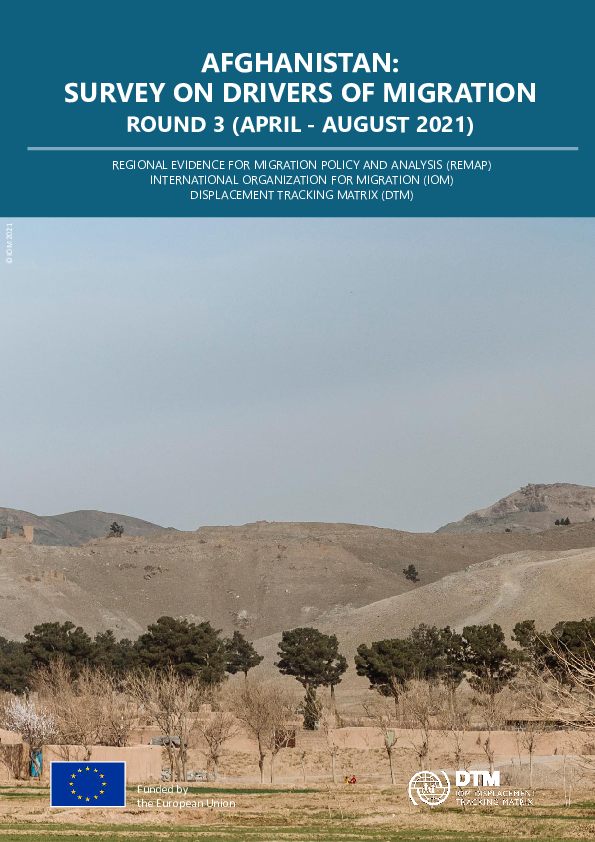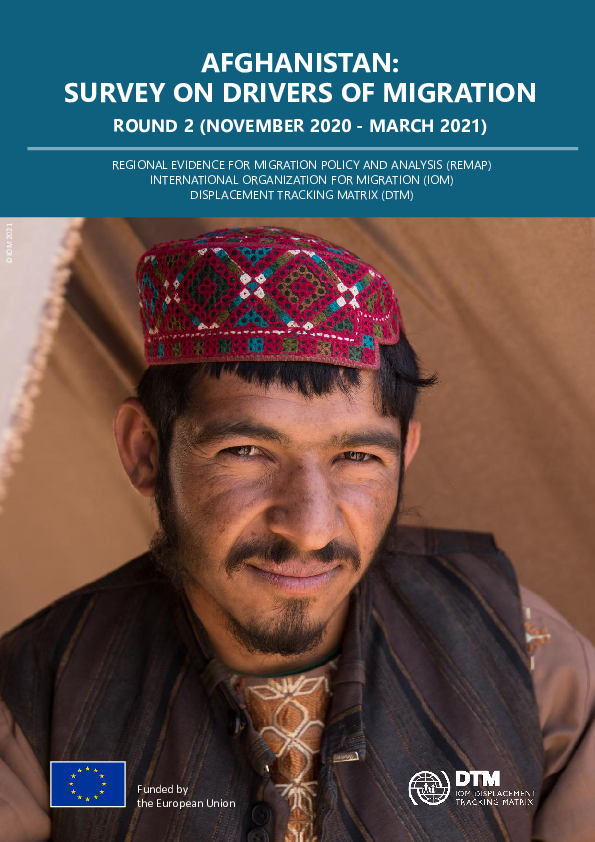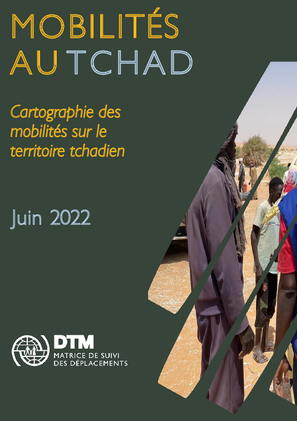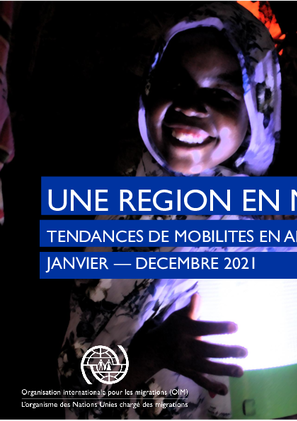-
Countries
-
Data and Analysis
-
Special Focus
-
Crisis Responses
Return Intention

Contact
dtmremapsupport@iom.int
Language
English
Location
Afghanistan
Period Covered
Apr 01 2021
Aug 31 2021
Activity
- Survey
- Flow Monitoring Survey
- Return Intention
This report demonstrates how Afghan mobility is the result of a range of factors related to economic conditions and prolonged conflict within the country. Between April 2021 and August 2021 (Round 3 of SDM), various provinces of Afghanistan were affected by active conflict, which was followed by the fall of the government in Afghanistan on 15 August 2021. This resulted in civilian casualties, the loss of livelihoods, internal displacement, and cross-border mobility. Therefore, the decisions to leave Afghanistan and choose a destination country revolved around multiple intersections of these factors as opposed to an identifiable, single reason.

Contact
dtmremapsupport@iom.int
Language
English
Location
Afghanistan
Period Covered
Nov 01 2020
Mar 31 2021
Activity
- Survey
- Flow Monitoring Survey
- Return Intention
This report will demonstrate how Afghan mobility is the result of a range of factors related to economic conditions and prolonged conflict within the country. Most importantly, these factors are mutually reinforcing, exacerbating one another and emphasizing the multifaceted nature of migration out of Afghanistan. During the reporting period, between November 2020 and March 2021 (Round 2), the decisions to leave Afghanistan and to choose a destination country revolved primarily around the intersection of economic conditions and conflict within the country. Those leaving Afghanistan, therefore, were motivated by the multiple intersections of these factors as opposed to an identifiable single reason.

Contact
DTM Europe, DTMMediterranean@iom.int
Language
English
Location
Republic of Moldova
Period Covered
Jun 07 2022
Jul 18 2022
Activity
- Survey
- Return Intention
Since 24 February 2022, an increasing number of people fleeing from Ukraine to the neighbouring countries has been observed, as a result of the war in Ukraine. As of 18 July 2022, 538,602 refugees from Ukrainian and other third country nationals (TCNs) were registered at border crossing points (BCPs) while entering from Ukraine into the Republic of Moldova.
112,958 Ukrainians and TCNs, who have entered into the Republic of Moldova after 24 February, have since exited back to Ukraine (Source: General Inspectorate for Border Police).
This report presents the main findings of the displacement surveys commissioned by the International Organization for Migration (IOM) in partnership with UN Women to CBS Axa Research. Data were collected before crossing to Ukraine at two main border crossing points (BCPs) – Palanca and Otaci – between 16 April and 18 July 2022. This report focuses on data collected between 07 June and 18 July 2022. Individuals crossing into Ukraine are not necessarily returnees and conclusions on definitive trends cannot be drawn. The sample is not representative of all persons crossing to Ukraine, and results should only be considered as indicative.

Contact
DTM Europe, DTMMediterranean@iom.int
Language
English
Location
Slovakia
Period Covered
Mar 09 2022
Jun 30 2022
Activity
- Survey
- Return Intention
Since 24 February 2022, an increasing number of Ukrainian refugees and third-country nationals (TCNs) entering Slovakia has been registered as a result of the war in Ukraine. As of 14 July 2022, Slovak authorities have reported 603, 957 arrivals from Ukraine out of whom 561, 939 were Ukrainian refugees and 14, 686 third-country nationals (TCNs). This report is based on displacement patterns, needs and intentions survey launched by IOM Displacement Tracking Matrix (DTM). All surveys were conducted face-to-face by IOM Slovakia trained enumerators with Ukrainian refugees and TCNs fleeing Ukraine. This report presents a short analysis based on 1,027 surveys collected between 9 March and 30 June 2022.

Contact
DTM Tchad, dtmtchad@iom.int
Language
French
Location
Chad
Snapshot Date
Jun 30 2022
Activity
- Other
- Survey
- Flow Monitoring Survey
- Return Intention
- Registration
- Rapid Emergency Registration
- Flow Monitoring
- Migrants presence
- Mobility Tracking
- Site Assessment
- Event Tracking
- Baseline Assessment
- Village Assessment
Ce rapport est composé d’un ensemble de cartes présentant les différents phénomènes et tendances migratoires au Tchad. Il décrit les différents mouvements de populations recensés depuis, vers et au sein du territoire tchadien et dresse le profil des populations en mouvement. Parmi les types de mobilités traitées dans ce document figurent les mouvements socioéconomiques; les mouvements de Tchadiens vers l’étranger et de ressortissants étrangers au Tchad; les transhumances ; les déplacements forcés et les retours facilités par l’OIM. Souvent, ces différentes mobilités se croisent et s’imbriquent. Ce rapport tente de mettre en lumière ce lien et de mieux saisir les dynamiques y afférentes. Ce rapport est le résultat d’une compilation de diverses bases de données, de rapports provenant de différentes sources d’information et de témoignages recueillis directement auprès des populations mobiles ou d’informateurs clés. Les sources sont indiquées dans chacune des pages. S’il ne peut pas être considéré comme complet ou représentatif, le rapport offre une image générale de la situation migratoire au Tchad.

Contact
DTM Europe, DTMMediterranean@iom.int
Language
English
Location
Republic of Moldova
Period Covered
Apr 16 2022
May 27 2022
Activity
- Survey
- Return Intention
Since 24 February 2022, an increasing number of people fleeing from Ukraine to the neighbouring countries has been observed, as a result of the war in Ukraine. As of 7 June, 489,283 Ukrainian refugees and third country nationals (TCNs) were registered at border crossing points (BCPs) while entering from Ukraine into the Republic of Moldova. Additionally, 87,621 Ukrainian refugees and TCNs, who have entered into the Republic of Moldova after 24 February, have since exited back to Ukraine.
This report presents a summary of displacement survey findings commissioned by the International Organization for Migration (IOM) in partnership with UN Women. Data were collected before crossing to Ukraine at three main border crossing points (BCPs) – Palanca and Tudora (Stefan Voda district in the South) and Otaci (Ocnita district in the North) between 16 April and 27 May. Individual crossings into Ukraine are not necessarily returnees and conclusions on definitive trends cannot yet be drawn. The sample is not representative of all persons crossing to Ukraine, and results should only be considered as indicative.

Contact
DTM South Sudan, SouthSudanDTM@iom.int
Language
English
Location
South Sudan
Period Covered
Sep 22 2021
Oct 19 2021
Activity
- Survey
- Return Intention
Between September and November 2021, the International Organization for Migration’s Displacement Tracking Matrix (IOM DTM) undertook its second household-level multi-sector assessment of selected urban areas and camps for internally displaced persons (IDPs) in South Sudan. The assessment aims to:
- Quantify the prevalence of vulnerabilities and humanitarian needs across sectors, with a focus on food security, economic vulnerability and nutrition as well as selected indicators on shelter and non-food items (SNFI), education, health, water, hygiene and sanitation (WASH), protection (including child protection and gender-based violence) and mental health and psycho-social support (MHPSS).
- Generate a better understanding of urban displacement and migration, including return and relocation after displacement in South Sudan or abroad.
This survey is part of the country-wide extended Food Security and Nutrition Monitoring System (FSNMS+) assessment in South Sudan, jointly conducted by IOM, the World Food Programme (WFP), the United Nations Children’s Fund (UNICEF), the Food and Agriculture Organization (FAO), the United Nations Office for the Coordination of Humanitarian Affairs (OCHA), REACH and several humanitarian clusters. It was designed to be an independent, crisis-wide and coordinated inter-agency multi-sectoral needs assessment, mandated by the Humanitarian Country Team and endorsed by the Inter- Cluster Coordination Group. Together, the joint findings provide an evidence-base for the Integrated Food Security Phase Classification, the Humanitarian Needs Overview and the Humanitarian Response Plan.
This report presents sectoral findings for the urban area of Yei.
Separate profiles have been published for the urban areas of Juba, Wau, Bor, Malakal and Bentiu / Rubkona.
Further profiles will be published for Juba IDP Camps I and III, Naivasha IDP Camp, Bentiu IDP Camp and Malakal Protection of Civilians (PoC) Site.

Contact
DTM Europe, DTMMediterranean@iom.int
Language
English
Location
Slovakia
Period Covered
Mar 09 2022
May 22 2022
Activity
- Survey
- Return Intention
Since 24 February 2022, an increasing number of refugees and third-country nationals (TCNs) entering Slovakia has been registered as a result of the war in Ukraine. As of 25th May, Slovak authorities have reported 454,023 arrivals from Ukraine out of whom 419, 710 were Ukrainian refugees and 13, 899 third-country nationals (TCNs).
This report is based on a displacement patterns, needs and intentions survey launched by IOM Displacement Tracking Matrix (DTM). All surveys were conducted face-to-face by IOM Slovakia trained enumerators with Ukrainian refugees and TCNs fleeing Ukraine. This report presents a short analysis based on 780 surveys collected between 9 March and 22 May 2022.

Contact
RO Dakar, RODakar-DataResearch@iom.int
Language
French
Activity
- Other
- Survey
- Community Perception
- Flow Monitoring Survey
- Return Intention
- Registration
- Flow Monitoring
- Migrants presence
- Mobility Tracking
- Site Assessment
- Event Tracking
- Baseline Assessment
- Points of Entry (PoE)
Le présent rapport vise à fournir un aperçu sur les tendances principales de mobilités de populations en Afrique de l’Ouest et du Centre en 2021. Il aborde la mobilité régionale selon deux grandes lignes : les déplacements internes et les flux migratoires. Dans chaque section, le rapport présente des tendances primaires de mobilités, les évènements clés, et les profils de populations mobiles observées en 2021. L’édition 2020 de ce rapport contient en outre des sections qui examinent en détail l’impact de la crise de COVID-19 sur la mobilité régionale, les migrations environnementales et climatiques et les solutions durables aux déplacements forcés dans la région.

Contact
DTM South Sudan, SouthSudanDTM@iom.int
Language
English
Location
South Sudan
Period Covered
Oct 02 2021
Oct 23 2021
Activity
- Survey
- Return Intention
Between September and November 2021, the International Organization for Migration’s Displacement Tracking Matrix (IOM DTM) undertook its second household-level multi-sector assessment of selected urban areas and camps for internally displaced persons (IDPs) in South Sudan. The assessment aims to:
- Quantify the prevalence of vulnerabilities and humanitarian needs across sectors, with a focus on food security, economic vulnerability and nutrition as well as selected indicators on shelter and non-food items (SNFI), education, health, water, hygiene and sanitation (WASH), protection (including child protection and gender-based violence) and mental health and psycho-social support (MHPSS).
- Generate a better understanding of urban displacement and migration, including return and relocation after displacement in South Sudan or abroad.
This survey is part of the country-wide extended Food Security and Nutrition Monitoring System (FSNMS+) assessment in South Sudan, jointly conducted by IOM, the World Food Programme (WFP), the United Nations Children’s Fund (UNICEF), the Food and Agriculture Organization (FAO), the United Nations Office for the Coordination of Humanitarian Affairs (OCHA), REACH and several humanitarian clusters. It was designed to be an independent, crisis-wide and coordinated inter-agency multi-sectoral needs assessment, mandated by the Humanitarian Country Team and endorsed by the Inter- Cluster Coordination Group. Together, the joint findings provide an evidence-base for the Integrated Food Security Phase Classification, the Humanitarian Needs Overview and the Humanitarian Response Plan.
This report presents sectoral findings for the urban area of Malakal.
Separate profiles have been published for the urban areas of Juba, Wau, Bor, Yei and Bentiu / Rubkona.
Further profiles will be published for Juba IDP Camps I and III, Naivasha IDP Camp, Bentiu IDP Camp and Malakal Protection of Civilians (PoC) Site.
Pagination
- Previous page
- Page 16
- Next page
